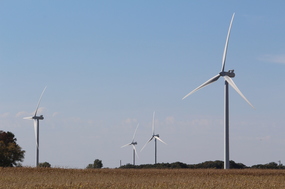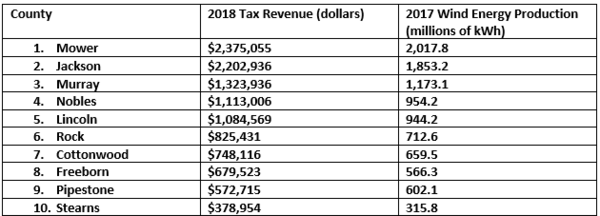Clean Energy
 Wind energy production taxes boost Minnesota county coffers; solar energy production taxes bump local revenues, too
Mower County and 26 other Minnesota counties will receive about $12.7 million in wind energy production taxes this year, according to figures from the Minnesota Department of Revenue. Mower County is the state’s top recipient of wind tax revenue and will receive nearly $2.4 million this year based on the 2017 electricity generation of wind farms in the county. Jackson County will receive the second most at $2.2 million. Other counties receiving at least $1 million include Murray ($1.3 million), Nobles ($1.1 million), and Lincoln ($1.1 million).
Mower County was the leading wind energy producer in Minnesota for 2017 with 2,018 million kilowatt hours, and it is grateful for the positive economic impact of wind energy. The development of large wind farms in this southeastern county has been embraced by most in the community, according to Tim Gabrielson, a commissioner on the Mower County Board of Commissioners.
“In addition to the production tax revenue, wind farms are creating jobs and providing income for landowners who lease their land to wind developers,” said Gabrielson. “It’s also great that wind provides a clean alternative to electricity generated by fossil fuels, so wind is good for our environment and good for health reasons."
Gabrielson said the county normally puts all of its wind production tax revenue into a general fund to keep the tax levy down. But last year it decided that $400,000 from the Pleasant Valley wind farm would be designated for improving roads and bridges this year.
Since 2008, Mower County has received about $17 million from wind production taxes. Over that same 11-year period, Minnesota counties have received about $90 million overall. Wind energy is good for the economy and helps achieve the state’s clean energy goals, said Gabrielson. “It’s really been a win-win for our community.”
In 2017, Minnesota ranked seventh in the nation for wind as a share of total in-state electricity generation, with 18.2% (3,509 MW) of Minnesota’s electricity coming from wind. In 2007, just 4.8% of the state’s electricity was generated by wind.
More than 1 gigawatt of new Minnesota wind energy planned for next 3 years
No new large wind farms are planned for Mower County, but a number of big wind
projects are planned or in the works, including: two new 200-MW wind farms in
Lincoln County for completion by 2020; a 200-MW wind farm in
Dodge County for completion in 2020; a
250-MW wind farm in Nobles County for 2019; a 150-MW wind farm for Yellow
Medicine County by 2019; and 84 MW of new wind in Freeborn County as part of a 200-MW wind farm that stretches into Iowa, to be completed by 2020.
Read more on how wind farms are growing local tax bases nationwide in a Moody’s Investors Service report.
Chisago County is top solar energy production tax recipient
The proliferation of large utility-scale solar farms and community solar gardens in the last two years has bolstered the economies of at least 30 Minnesota counties. Chisago County, home to the 100-MW North Star Solar project, will receive $314,000 in solar energy production tax revenue this year based on 262,000 MWh of production in 2017. According to the Department of Revenue, Lyon County at $135,000 and Stearns County at $125,000 were right behind Chisago as Minnesota’s leading solar tax revenue counties. Similar to wind, landowners who lease their land to solar developers are increasing their incomes.
|
Top 10 Minnesota counties -- Wind Energy Production Tax

Clean Energy Economy Minnesota makes its case for clean energy
A clean energy
business association is gaining traction in Minnesota with a simple message:
Clean energy means jobs and economic development. Clean Energy Economy Minnesota, in its second year, has
raised its profile at the State Capitol and is forging relationships with rural
and suburban conservatives. Read more as reported in Midwest Energy News.
CERTs offers conference recap, access to clean energy
presentations
In case you missed the Clean Energy Resource Teams (CERTs)
2018 Community Driven Clean Energy Conference in March, CERTs
offers a look back at the event, including the ability to access presentations
from 80 speakers who shared their experience and expertise. Read
more to view the recap and conference
presentations.
 Solar News
California to require solar on all new homes starting in 2020
The California Energy Commission approved the 2019 Building Energy Code on
May 9, requiring renewable energy access for all new residential homes in the
state starting in 2020. The code includes incentives for energy storage while
mandating that the construction of new homes include advanced energy efficiency
measures and rooftop solar. The mandate could require between 68 and 241 MW of
annual distributed solar buildout. This historic
revision of building energy codes ensures a large investment in
residential rooftop solar and energy efficiency as California pursues its
mandate of getting 50% of its energy from renewables by 2030. Read
more.
SEPA issues community solar garden report
The total installed capacity of community solar
programs in the United States has expanded to 734 megawatts (MW), with
approximately 387 MW of that being installed in 2017, according to a community
solar gardens report by the Smart Electric Power Alliance (SEPA). Minnesota is
the nation’s leader in electricity generated by community solar gardens, with
287 MW as the end of 2017. SEPA has researched and catalogued community solar
programs since 2010 and has collected an extensive database on every launched
program and publicly announced program. Access the report: “Community Solar
Program Design Models”
(pdf). Also from SEPA, see “Financial Community-Based Solar
Projects: Case Studies from the Field.”
|
Wind News
2017 Distributed Wind Market Report Fact Sheet is available
Cumulative
U.S. distributed wind installed capacity now exceeds 1 gigawatt (1,076
megawatts), according to the U.S. Department of Energy’s annual Distributed Wind Market Report Fact Sheet. Each year, the
Wind Energy Technologies Office publishes a fact sheet as a preview of the full
market report. The report will provide market research, data, and analysis to
help interested parties, policymakers, and industry understand the issues
unique to distributed wind in the United States. The fact
sheet is available (pdf) and the full report will be published this summer.
DOE offers distributed wind installers list
The U.S. Department of Energy’s Wind Energy Technologies
Office has created a distributed wind installers list on OpenEI. This list of distributed wind installers is provided for
consumers' reference, and it does not represent an endorsement of any
installer. Installers in the list are active in the distributed wind market and
have opted-in to be included. OpenEI is a wiki-site and therefore contributors
can add installers to the list as well.
New U.S. Wind Turbine Database is released
The U.S. Department of Energy recently released its new U.S. Wind Turbine Database. The database contains
more than 57,000 turbines, constructed from the 1980s through 2018, and
includes characteristics such as the turbines' make and model, height, rotor
diameter, year of installation, and rated capacity. The database does not
include all small and distributed wind turbines.
Conferences & Workshops
Twenty-ninth annual Energy Fair to be held June 15-17 in Custer, Wis.
The
29th-annual Energy Fair will be held June 15-17 in Custer, Wis., and
will attract over 13,000 people to learn about clean energy and sustainability,
connect with others, and take action towards a sustainable future. The Energy
Fair, organized by the Midwest Renewable Energy Association,
features
interactive workshops, exhibitors, live music, inspiring keynote speakers, and
family fun. It is the longest-running event of its kind in the nation.
Read more.
Community Solar Power Summit is July 18-19 in Minneapolis
The Community Solar Power Summit will be
held July 18-19 at the Radisson Blu Downtown Minneapolis. The Summit, produced
by the Coalition for Community Solar Access (CCSA), brings together leading
community solar businesses, utilities, nonprofits, and policymakers for a
two-day event featuring in-depth conversations with national community solar
leaders from CCSA, Solar Energy Industries Association (SEIA), Smart Electric
Power Alliance (SEPA), and other industry leaders. Read more.
MnSEIA Midwest Gateway to Solar Conference is Nov. 13-14
The Minnesota Solar Energy Industries Association (MnSEIA) will host
the fifth-annual MnSEIA Midwest Gateway to Solar Conference on Nov. 13-14 at
the Hilton Hotel in Bloomington, Minn. The conference will focus on the state of solar
in Minnesota, the Midwest, and the nation. It will bring together
solar industry practitioners from all over the country for education,
networking, and MnSEIA’s plans to grow Minnesota’s solar market. To register
and for more details, read more.
Renewable News is a newsletter that covers a range of renewable energy topics, including innovative initiatives in our state, technological advancements, financial incentives, trainings, and events. If you would like to change preferences for the newsletters you are currently subscribed to or if you want to unsubscribe, please use the links at the bottom of this page.
|